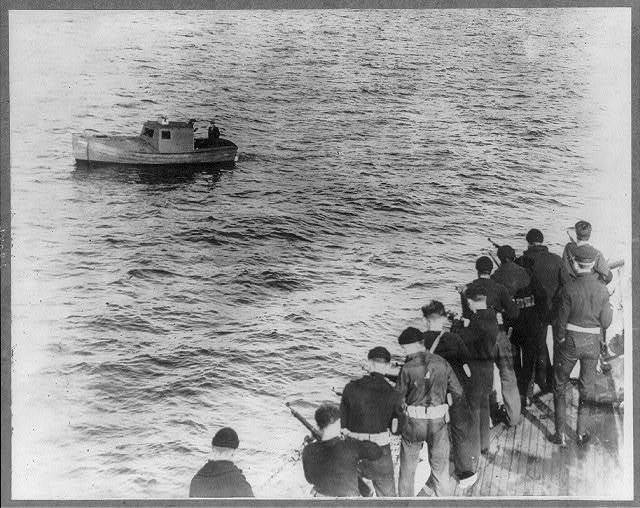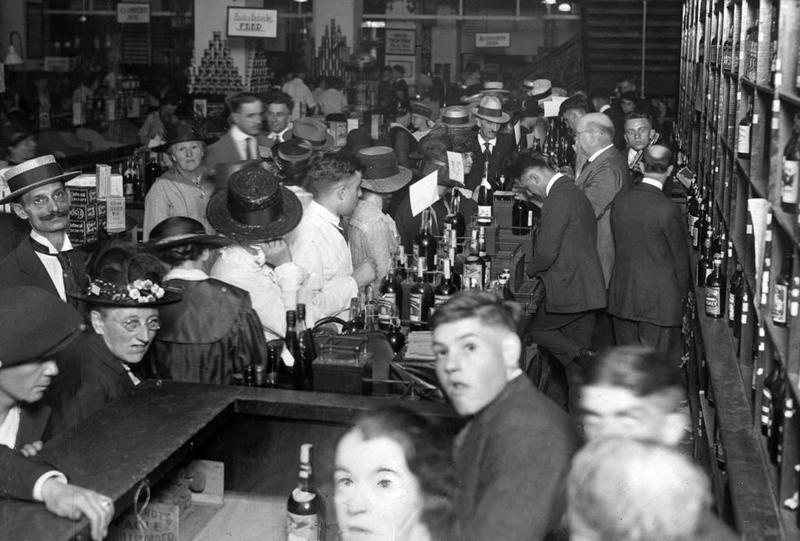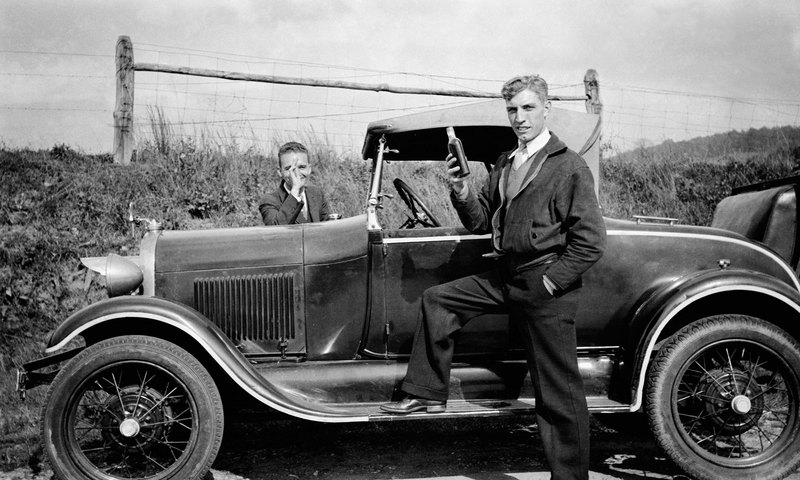Bootlegging During Prohibition
“January 16, 1920, was the last day on the job for countless Americans who worked in the legal liquor industry. The Volstead law threatened the livelihood of everybody in the liquor trade from the big bosses down to the guys who swept the barroom floor.”[1] According to the Bureau of Internal Revenue, Prohibition was closing 236 distilleries, one thousand breweries, and 177,790 retail liquor outlets[2], and it was entirely up to the individual businesses to find new ways to survive.
As citizens scrambled to build up their own personal reserve some companies liquidated their stocks. Others focused on shipping millions of dollars worth of liquor off of the Atlantic coast and Gulf of Mexico. These shipments were bound for Europe, Central America, and the Caribbean[3]. On the West coast exporters shipped booze to the Asian mainland and Pacific Islands[4]. There were even speculators that shipped off loads of liquor to be stored in Foreign warehouses, so that when the liquor market finally opened up, they would be able to sell decent liquor to thirsty Americans for top dollar.
Others sought to adapt to the new regulations by finding new ways to use their equipment and resources. Vintners that didn’t uproot their grape vines for a different crop could still cultivate and sell grapes if they wished, but they would have to adhere to the law, only producing wine for sacrificial purposes. Breweries shared this versatility and if they didn’t want to apply for a government license to brew near beer, they could in most cases use their equipment for other sorts of food production[5].
The brewing company Anheuser-Busch began the process of diversification after Prohibition by adapting their equipment for other uses like the production of ice cream, ginger ale, root beer, grape drinks, syrups, yeast, tonics, starch, glucose, malt extract, and livestock feed as well as near beer[6].
Distilleries on the other hand were not so versatile. They essentially had three options to choose from. They could seal up their distilleries with whiskey sitting in barrels in hopes that owners could eventually score a medical label for their liquor. They could attempt to ship their equipment to places like Canada to set up shop or exporters could ship millions of gallons of bourbon to distant shores namely England and Ireland. These exporters claimed to have the intention of selling, but skeptics back home believed they would just smuggle it back inside of the country after Prohibition took effect[7].
Papa’s in the shed, mixing up the mash; Junior’s in the parlor, counting all the cash; Mama’s in the kitchen, washing out the mugs; Sister’s in the pantry, filling up the jugs.— Anonymous
Skeptics were right in thinking that liquor would eventually be smuggled back into the country, but before that could happen, activists opposing Prohibition were already using their constitutional right to free press in order to print and circulate beer recipes to the public. The most famous recipe for brewing beer that was distributed was one that George Washington had written in his notebook during his days serving in the Virginia Militia[8].
The government knew that it could not eliminate alcohol production completely within the U.S especially because it was needed for industrial, culinary, and cosmetic purposes. They could however make it taste terrible and in some cases poisonous. They added different combinations of chemicals to make the alcohol undrinkable, and in some cases a violent poison, but the public feared not. Bootleggers were constantly attempting to find out which chemical had been added, so that they could redistill the liquor and boil it out once again making“clean” liquor that they could sell[9].
Bootleggers were not necessarily all criminals before Prohibition in fact many of them were just ordinary citizens who either didn’t agree with Prohibition or needed to find a way to live under its rule. Regardless of their criminal status many citizens took it upon themselves to brew and distill drink for the underground market. For example, many American vintners in California chose to continue to produce wine both for legal religious purposes and for the growing black market[10].
This was the case with the Colombano family during the 1920’s; the youngest son described his experience with bootlegging. “My father had been a farmer in Italy. He understood grapes. And he knew how to make wine. So my uncle suggested to my father that they should go north and find some land and before long Eligio was making good red wine and Camillo was trucking it down to San Francisco in the middle of the night"[11].
As prohibition took hold, the vineyards of California that continued to grow grapes despite the predictions that prohibition would destroy the market saw a tremendous increase in demand for their product. In 1922 California vineyards were shipping so many grapes to the east coast that railroad companies had a shortage of refrigerated cars[12].
After the Volstead Act went into effect this was the common case for most illegal alcohol producers. For the most part it was not hard to obtain materials to make drinkable alcohol, and the demand was greater than ever. The real trouble was how to conceal its production, transportation and sale from the law.
For most Bootleggers the Sale of Alcohol was hidden within the walls of establishments called speakeasies, blind pigs, blind tigers, beer flats or rat dives. No matter the name or the caliber of these establishments they all centered around one main objective: the sale of alcohol. These clubs opened up all over the major cities of both coasts. The Philadelphia police estimated that their city had at least eight thousand illegal watering holes in 1923. Five years later, Philly’s mayor said the City of Brotherly Love had thirteen thousand illegal drinking spots[13].
In the Midwest Chicago became the hub for illegal activity. According to a news paper report, Chicago had at least 4,000 bars openly selling drinks in 1921. Two years later, Chicago’s mayor said that there were 6,000 soft-drink parlors that were selling far more booze than soda.[14]
But it wasn’t just the big cities that saw an explosion of bootleg bars after Prohibition. Places like Minnesota saw the same thing, and Newspapers referred to the abundance of “Blind Pigs” in their reports. Blind Pigs worked best in smaller areas because these establishments found ways to serve the customer booze without ever meeting face to face. “A syndicated columnist wrote that he found a blind pig only “a few rods” away from the famous Falls of Minnehaha. When he went inside to visit the “sightless swine,” he saw “a dumbwaiter, which briefly disappeared and then returned with a glass of liquor.”[15]
An important aspect of the bootlegging business was transportation, and in order to be successful a bootlegger must be quick and crafty. This meant that the first thing a bootlegger needed a fast car. Automobiles with six-cylinder engines were the preferred choice, so much so that they earned the moniker “Whiskey Six”[16]. These cars also needed to be large enough to carry payload worthwhile, and it was not uncommon for bootlegger to modify the interior of cars with secrete panels, and in some case gas tanks that we sectioned off to hold both fuel and booze.
Even if a bootlegger had a fast car, they would only be successful if they had the skill to handle it. Lloyd Seay was one of those men. Lloyd was a Georgia native who began running moonshine between states at an early age earning a reputation with law enforcement in the area, and an account of a meeting with Seay by an officer exemplifies the spirit of this bootlegger and many like him. The police chief of a town north of Atlanta took off after a black '39 coupe as it roared through the town square at noon. It was Lloyd Seay again, headed home to Dawsonville to fetch another load of moonshine whiskey to be ferried to the city. The cop found Seay impatiently sitting behind the wheel of the car, revving his engine, calmly sticking two five-dollar bills out the window.[17]
''Dammit Lloyd, you know the fine for speedin' ain't but five dollars,'' said the chief.
''Yeah,'' said Seay, ''but I'm gon' be in a hurry comin' back, so I'm payin' an advance.''[18]
Two months after his encounter with the police chief, he took home $450 by winning the big Labor Day race at Lakewood. But the very next morning, in a dispute with a cousin over sugar, essential to making home brew, he died of a gunshot wound through the heart at the age of 21. ''When not racing,'' read an obituary in The Atlanta Journal, ''Mr. Seay divided his time between Dawsonville and Atlanta.''[19]
Lloyd Seay and other backwoods bootleggers of the southeast would not only become cultural icons of the anti-prohibition movement, but they would help spark a racing organization that would eventually be known as NASCAR.
The government planned on public resistance during prohibition, but they were not prepared to deal with a nation of bootleggers willing to go to any length to produce, and provide alcohol to the American public.
[1] Funderburg, J. Anne. Bootleggers and Beer Barons of the Prohibition Era. Jefferson NC, US: McFarland, 2014. ProQuest ebrary. Copyright © 2014. McFarland.
[2] “Nation Goes Dry at Midnight,” Ironwood Daily Globe (Ironwood, MI), January 1 6, 1920.
[3] Mills, Eric. Chesapeake Rumrunners of the Roaring Twenties. Centreville, MD: Tidewater Publishers, 2000.
[4] Norton, Wayne. "Closing Time: Prohibition, Rum-Runners, and Border Wars." BC Studies, no. 188 (2015): 130.
[5] Funderburg, J. Anne. Bootleggers and Beer Barons of the Prohibition Era. Jefferson NC, US: McFarland, 2014. ProQuest ebrary. Copyright © 2014. McFarland.
[6] Funderburg, J. Anne. Bootleggers and Beer Barons of the Prohibition Era. Jefferson NC, US: McFarland, 2014. ProQuest ebrary. Copyright © 2014. McFarland.
[7] Burns, Ken, Novick, Lynn, and Kanopy. Prohibition -Episode 2. San Francisco, California, USA]: Kanopy Streaming, 2015
[8] Walnut, Thomas Henry, and King, Clyde L. Prohibition and Its Enforcement ...American Academy of Political and Social Science. Annals. ; Vol. CIX No. 198. Philadelphia: American Academy of Political and Social Science, 1923.
[9] Funderburg, J. Anne. Bootleggers and Beer Barons of the Prohibition Era. Jefferson NC, US: McFarland, 2014. ProQuest ebrary. Copyright © 2014. McFarland.
[10] Sosnowski, Vivienne. "Making Bootleg Wine in California." In Prohibition, edited by Sylvia Engdahl, 183-190. Perspectives on Modern World History. Detroit: Greenhaven Press, 2013. Gale Virtual Reference Library
[11] Sosnowski, Vivienne. "Making Bootleg Wine in California." In Prohibition, edited by Sylvia Engdahl, 183-190. Perspectives on Modern World History. Detroit: Greenhaven Press, 2013. Gale Virtual Reference Library
[12] Funderburg, J. Anne. Bootleggers and Beer Barons of the Prohibition Era. Jefferson NC, US: McFarland, 2014. ProQuest ebrary. Copyright © 2014. McFarland.
[13] Special to The New York Times. "PHILADELPHIA JURY PICTURES CITY EVILS." New York Times (1923-Current File) (New York, N.Y.), March 29, 1929.
[14] Special to The New York Times. "CHICAGO 'DRY' LID BLOWN OFF." New York Times (1857-1922) (New York, N.Y.), December 28, 1922.
[15] Funderburg, J. Anne. Bootleggers and Beer Barons of the Prohibition Era. Jefferson NC, US: McFarland, 2014. ProQuest ebrary. Copyright © 2014. McFarland.
[16] Funderburg, J. Anne. Bootleggers and Beer Barons of the Prohibition Era. Jefferson NC, US: McFarland, 2014. ProQuest ebrary. Copyright © 2014. McFarland.
[17] Funderburg, J. Anne. Bootleggers and Beer Barons of the Prohibition Era. Jefferson NC, US: McFarland, 2014. ProQuest ebrary. Copyright © 2014. McFarland.
[18] Hemphill, Paul. "One Last Lap Around the Speedway." The New York Times. 2001. Accessed December 01, 2016. http://www.nytimes.com/2001/02/24/opinion/one-last-lap-around-the-speedway.html.
[19] Hemphill, Paul. "One Last Lap Around the Speedway." The New York Times. 2001. Accessed December 01, 2016. http://www.nytimes.com/2001/02/24/opinion/one-last-lap-around-the-speedway.html.



